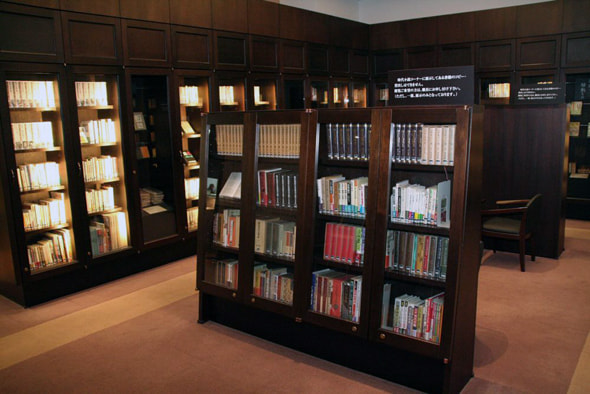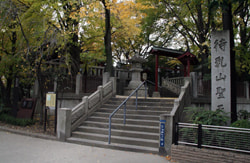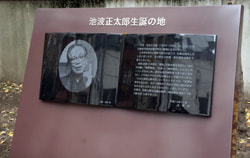Section of Japanese historical novels
Here is the section of Japanese historical novels, which is one of the main features in Ikeami Shotaro Memorial Museum. Ikenami's wife wanted us to collect not only Ikenami's works but also masterpieces of Japanese historical novels as many as possible for researchers and devotees of historical novels, and she provided a fund for that purpose. Before opening this library, we collected many historical novels. This collection includes precious books. For example, as you can find, there are a first edition of "Daibosatsu-touge" by Kaizan Nakazato, a first edition of "Kurama-tengu" by Jiro Osaragi, a first edition of "Zenigata Heiji" by Kodo Nomura, a first edition of "Miyamoto Musashi" by Eiji Yoshikawa and a first edition of "Ako-roshi" by Jiro Osaragi, all of which are very important materials.(continued in the right column)
This library now houses approximately 8,000 books, including first editions of masterpieces, which had made the history of Japanese novels after the Taisho Era. In the field of historical novels, new writers have appeared every year, so we collect new books each time they are published. Therefore, according to Kazuo Nawata, a literary critic, who supervised this library, this might be a largest collection of masterpieces of historical novels in Japan. I think this section of historical novels is the biggest feature of the museum for the novelist, which is set up inside Taito City Library.(continued in the lower left column)

Section of Japanese historical novels, Ikenami Shotaro Memorial Museum
The reason why Ikenami depicted Edo
In his early career as a novelist, he mainly wrote about the last days of the Tokugawa shogunate and the period of civil wars, as depicted in "Sanada Taihei-ki." However, he focused on Edo in this late career. Why did he begin to write stories set in Edo only? Ryotaro Shiba wrote about the reason. They had been on good terms with each other, so I think Shiba pointed out it most appropriately. Ikenami was very concerned about the drastic changes of towns in Tokyo during the high-growth period from around 1955 to 1964, the time before the Olympic Games was held in Tokyo. He was an urbanite and neophilia, so he did not hate to see newly constructed urban beauty. However, there were cityscapes that he wanted to preserve. He was very anxious about the loss of these cityscapes. For example, he visited Senso-ji Temple every year, and, on his way home, ate soba noodles at a certain soba restaurant. However, when he went out thinking that there was the restaurant, it disappeared though Senso-ji Temple was still there. So he was very disappointed. He had such feelings. In short, he, who grew up in towns that had traces of Edo, depicted Edo as a town where he wanted to live all his life. It was a town that existed in his imagination. So he began to write stories set in Edo. This is Shiba's analysis, and I also think so.(continued in the right column)
Then, how did Ikenami know Edo? First of all, Edo existed in his mind. It was a town of Asakusa Nagasumi-cho. The essence of Edo remained strongly in that town. Therefore, when he was a child, there were many people who was born in the Edo Period and lived through the Mieji and Taisho Eras. It was still 60 to 70 years ago, so some of them had experienced the Battle of Ueno on May 15, 1868. So, naturally, there were always such remnants of Edo around him. He was also influenced by his grandfather and grandmother. So it can be pointed out that elements of Edo naturally sank into his mind. Since the Ueno area and towns in Taito City have long histories, he had experienced those things firsthand at that time. I think it is the primary reason why he knew Edo. Therefore, regarding how he understood Edo, there are not many materials.


A monument was built in 2007 at Ikenami's birthplace, Asakusa Shoden-cho, Taito City (old address: 61 Shoden-cho, Asakusa Ward, Tokyo City). His home was located on the south side (around the address of 7-3 Asakusa, Taito City) of Matsuchiyama Shoden Temple, but destroyed during the Great Kanto Earthquake.


A monument was built in 2007 at Ikenami's birthplace, Asakusa Shoden-cho, Taito City (old address: 61 Shoden-cho, Asakusa Ward, Tokyo City). His home was located on the south side (around the address of 7-3 Asakusa, Taito City) of Matsuchiyama Shoden Temple, but destroyed during the Great Kanto Earthquake.








